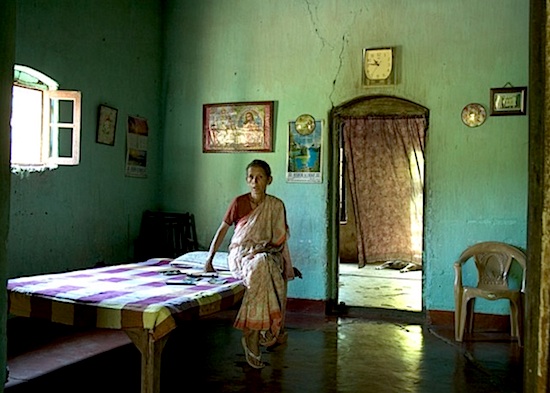I like bare concrete walls.
Let me explain why.
Many photo tour leaders are known for setting up photographs for their groups, and it's not unusual for photographers who repeat the same photo trips with the same itinerary to end up shooting the same 'models'...albeit looking a year or two older. I've heard anecdotes of how the 'models' know exactly how to pose, which side of their face is more flattering, and know where the dotted line on model releases are.
Due to the nature of my own photo expeditions-workshops which are "event-specific" and are structured around religious or cultural rituals (the more obscure and unique the better), and because my workshops are based on the concept of "photojournalism meets travel photography", I seldom need to set up pre-arranged photo shoots as such. For one thing, the religious/cultural events that I gravitate towards during these photo expeditions-workshops are too intense, too authentic and too crowded...and consequently make set-ups unnecessary, and possibly even disrespectful.
Moreover, the type of photographers who sign up for my photo expeditions-workshops are generally well-seasoned, experienced and are self-starters...who, not only are perfectly capable of 'de-clustering' themselves from each other, but do what good photographers do best...look for their own photo opportunities within the framework of the religious and/or cultural events.
That said, there are occasions during my photo expeditions-workshops when characters are so photogenic that they figuratively jump at me, and I just have to set-up a sort of "fashion" shoot, gather the group as quickly as I can, and start the fun. However, and as much as the characters' photogenic attributes are important, the backgrounds are also as critical.
What to do if a uniquely photogenic character presents himself/herself but no appropriate background is found? I suppose carrying some form of portable background (white, black or burlap colored cloth) would solve this problem, but what if this wasn't readily available as it was during a photo shoot at a Kathakali academy on my recent
The Oracles of Kerala Photo Expedition-Workshop?
We were photographing the pre-performance make-up session, and I was disappointed at the walls of the make-up area were painted a drab and blotchy kind of salmon pink, which didn't lend itself to an attractive background. However, a corner of the school was being newly built with walls of bare concrete. Bare concrete means gray and everybody knows that it helps in producing a consistent image exposure... so perfect!!!
The probability that we would all end up with the same image was my primary concern, but the light of day was perfect, the costume was perfect, the dancer was image-savvy and the performance was about to start. So we were shooting paparazzi-style for a few minutes...and despite the appearance of what photojournalists (and the military) describe as a "clusterfuck", we were all happy with the opportunity.
I asked the participants of
The Oracles of Kerala Photo Expedition-Workshop to send me their favorite(s) photograph from that shoot without telling them why...imagining that their photographs would be identical. They're not. Because of their experience, their difference in shooting styles and because of the dancer's adopting various poses, the results of that particular "clusterfuck" were satisfactory.
So much so that I've used my own image of the shoot for the background of
my website.
That's why I like bare concrete walls...and so should you.



























